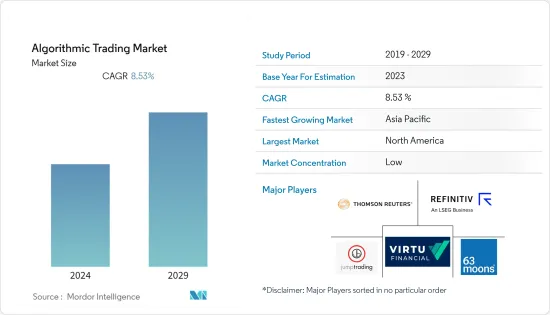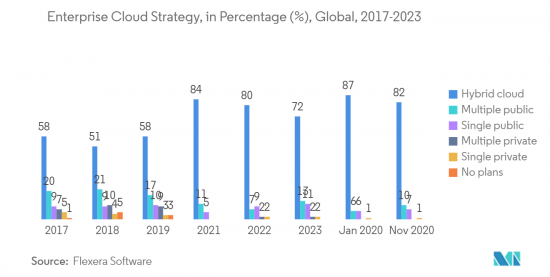 |
市場調查報告書
商品編碼
1404537
演算法交易:市場佔有率分析、產業趨勢/統計、成長預測,2024-2029Algorithmic Trading - Market Share Analysis, Industry Trends & Statistics, Growth Forecasts 2024 - 2029 |
||||||
※ 本網頁內容可能與最新版本有所差異。詳細情況請與我們聯繫。
今年演算法交易市場規模為144.2億美元,複合年成長率為8.53%,預計五年後將達237.4億美元。
交易者傳統上使用市場監控技術來追蹤他們的交易業務和投資組合。具有內建智慧的應用程式(例如演算法交易)可以根據用戶指定的收益率和其他參數探索市場中的不同機會。

主要亮點
- 由於有利的政府法規,對快速、可靠和高效的訂單執行的需求不斷增加,對市場監管的需求不斷增加以及交易成本的降低,預計演算法交易行業的需求將會增加。主要券商和機構投資者使用演算法交易來降低大量交易的成本。此外,人工智慧(AI)和金融服務演算法的發展預計將創造有吸引力的市場擴張機會。對雲端基礎的解決方案的需求不斷成長預計也將推動演算法交易市場的成長。
- 科技革命極大地改變了我們與世界互動的方式以及我們開展業務的方式。然而,它還遠遠沒有達到成熟,甚至更具顛覆性的技術和方法正在出現,有可能顛覆整個產業並創造全新的商業模式。近年來,先進和智慧型的交易系統隨著市場和技術的進步而發展。近年來,這些系統變得越來越普及,因為它們允許各種級別的自動交易。
- 自從現代交易所引入匹配引擎以來,演算法交易已在全球範圍內使用。透過消除人為限制,這些技術進步提高了市場處理訂單和交易的能力。結果,研究市場的時間範圍從秒變成毫秒,市場監控從交易場轉移到電腦。市場監督,無論是政府還是交易所,都可以保護市場誠信並保護市場參與企業免受不道德行為的影響。
- 雖然演算法交易有其好處,但它也可能透過導致崩盤(所謂的「閃電崩盤」)和即時流動性損失來放大所研究市場的負面趨勢。流動性的即時喪失可能會限制市場成長。
- 由於全球封鎖,COVID-19大流行導致對技術的依賴增加。動盪的市場環境、高交易量以及適應遠距工作環境的快速數位轉型正在導致演算法交易的興起。
演算法交易市場趨勢
雲端部署部分預計將推動市場成長
- 雲端技術提供了一種自動化流程以及高效儲存和管理資料的方法。雲端基礎的交易還具有在遠端伺服器上處理交易的優勢。這降低了現場IT基礎設施成本,並增強了用於事務測試和建模的雲端功能。
- 在雲端部署時代,雲端基礎的演算法交易平台預計將在市場成長中發揮關鍵作用。雲端基礎的交易解決方案可讓交易者自動化交易流程,從而實現利潤最大化,並使交易資料易於維護、擴充性、經濟高效且有效管理。這是因為它具有許多優勢,包括:
- 雲端基礎的交易在雲端運算模型上運行,通常使用可透過網際網路存取的遠端伺服器網路來管理、儲存和處理資料。雲端的便利性使得交易者可以在雲端部署演算法交易,在執行交易時確認新的交易策略、回測和時間序列分析。
- 眾所周知,在主要股票市場中,大多數股票交易都是使用執行交易策略的應用程式和機器人來自動化的。最近,金融服務業的新趨勢是將演算法交易解決方案等交易解決方案遷移到雲端。近年來,越來越多的交易者轉向基於雲端的演算法交易解決方案。
- 雲端的一大好處是業務敏捷性。利用輕鬆快速地存取雲端服務供應商的技術和持續創新的能力,同時還允許交易者試驗和試點新技術和解決方案,而無需進行大量的前期投資。我們採用即用計量收費模式。具體來說,資本市場公司可以透過多種使用案例和優勢將本地解決方案擴展到雲端或建構雲端原生解決方案。 Flexera Software 的數據顯示,截至 2023 年,72% 的企業受訪者表示他們已經採用了混合雲端。

預計北美將佔據較大市場佔有率
- 預計北美將佔據本次調查市場的最大佔有率。預測期內推動市場成長的關鍵因素是增加對交易技術(例如區塊鏈)的投資、演算法交易供應商的增加以及政府對該地區國際貿易的支持不斷增加。
- 隨著包括高頻交易 (HFT) 在內的演算法交易策略在美國證券市場變得普及,這些策略對市場和企業穩定性產生負面影響的可能性也在增加。
- 現代技術透過自動化所有相關交易步驟,正在迅速改變傳統投資模式的格式,從而開發出一個可供所有潛在投資者使用的安全有效的生態系統。
- 北美演算法交易市場在美國美國交易委員會(SEC)和金融業監管機構(FINRA)等機構管理的法律規範內運作。這些監管機構制定了規則和指南,以確保市場誠信、公平實踐和風險管理。
- 演算法交易獲得了資產管理公司、對沖基金和退休基金等機構投資者的大力支持。這些機構投資者採用演算法交易策略來提高效率、最佳化執行和管理風險。先進交易平台的可用性和市場資料的獲取促進了演算法交易的普及。
演算法交易產業概述
演算法交易市場高度分散,主要參與者包括湯森路透、Jump Trading LLC、Refinitiv Ltd、63 Moons Technologies Limited 和 Virtu Financial Inc.。市場參與者正在採取聯盟和收購等策略來加強其產品供應並獲得永續的競爭優勢。
其他福利
- Excel 格式的市場預測 (ME) 表
- 3 個月的分析師支持
目錄
第1章簡介
- 研究假設和市場定義
- 調查範圍
第2章調查方法
第3章執行摘要
第4章市場洞察
- 市場概況
- 產業吸引力-波特五力分析
- 供應商的議價能力
- 買家/消費者的議價能力
- 新進入者的威脅
- 替代品的威脅
- 競爭公司之間敵對關係的強度
- COVID-19 對市場的影響
- 技術簡介
- 演算法交易策略
- 動量交易
- 套利
- 跟隨潮流
- 基於執行的策略
- 情緒分析
- 指數型基金再平衡
- 基於數學模型的策略
- 其他演算法交易策略
- 演算法交易策略
第5章市場動態
- 市場促進因素
- 對快速、可靠、有效的訂單執行的需求不斷成長
- 由於交易成本降低,市場監管需求增加
- 市場抑制因素
- 即時失去流動性
第6章市場區隔
- 按交易者類型
- 機構投資者
- 個人投資者
- 長期交易者
- 短期交易者
- 按成分
- 解決方案
- 平台
- 軟體工具
- 服務
- 解決方案
- 按發展
- 在雲端
- 本地
- 按組織規模
- 中小企業
- 主要企業
- 按地區
- 北美洲
- 歐洲
- 亞太地區
- 拉丁美洲
- 中東/非洲
第7章競爭形勢
- 公司簡介
- Thomson Reuters
- Jump Trading LLC
- Refinitiv Ltd
- 63 Moons Technologies Limited
- Virtu Financial Inc.
- MetaQuotes Software Corp.
- Symphony Fintech Solutions Pvt. Ltd
- Info Reach Inc.
- ARGO SE
- IG Group
- Kuberre Systems Inc.
- Algo Trader AG
第8章投資分析
第9章 市場機會及未來趨勢

The Algorithmic Trading Market was valued at USD 14.42 billion in the current year and is expected to register a CAGR of 8.53%, reaching USD 23.74 billion in five years. Traders have traditionally used market surveillance technology to keep track of their trading operations and investment portfolios. Applications with built-in intelligence, like algorithmic trading, can explore the market for various opportunities based on the yield and other parameters the user specifies.
Key Highlights
- The need for the algorithmic trading industry is anticipated to be driven by favorable governmental rules, rising demand for quick, reliable, and efficient order execution, increasing demand for market surveillance, and declining transaction costs. Large brokerage firms and institutional investors use algorithmic trading to reduce the expenses of bulk trading. Additionally, it is anticipated that the development of artificial intelligence (AI) and financial service algorithms will create attractive market expansion opportunities. A rise in the demand for cloud-based solutions is also anticipated to support the growth of the algorithmic trading market.
- The technological revolution has altered how one can interact with the world and do business. But, far from reaching maturity, the revolution continues to unfold, revealing even more disruptive technologies and approaches capable of disrupting entire industries and spawning significantly new business models. Advanced and intelligent trading systems have evolved with markets and technological advances in recent years. These systems have become increasingly popular in recent years as they enable different levels of automated trading.
- Since the introduction of matching engines in modern exchanges, algorithmic trading has been used globally. By removing human restrictions, such technological advancements have enhanced the capacity of markets to process orders and trades. As a result, the studied market's timeline shifted from seconds to milliseconds, and market surveillance was transferred from the trading pit to computers. Whether conducted by a government or an exchange, market surveillance safeguards market integrity and protects participants from unethical behavior.
- While algorithmic trading has its advantages, it can also amplify the negative trends in the market studied by causing crashes (so-called "flash crashes") and immediate loss of liquidity. The instant loss of liquidity can restrain market growth.
- The COVID-19 pandemic led to increased dependence on technologies owing to the global lockdowns. The volatile market conditions, high trading volume, and drive for rapid digital transformation to cope with the remote working environment have all contributed to the uptick in algorithmic trading.
Algorithmic Trading Market Trends
On-cloud Deployment Segment is expected to drive the Market Growth
- Cloud technologies provide ways to automate processes and efficiently store and maintain data. In addition, cloud-based trading offers the benefits of remote servers to process trades. This reduces onsite IT infrastructure costs and augments the cloud's power to test and model trades.
- In the age of cloud deployment, cloud-based algorithmic trading platforms are projected to play a crucial role in the growth of the market, owing to various benefits, such as obtaining maximum profits, as cloud-based trading solutions enable traders to automate their trading process, easy trade data maintenance, scalability, cost-effectiveness, and effective management.
- Cloud-based trading works on the cloud computing model, which uses networks of remote servers generally accessed over the internet to manage, store, and process data. Attributed to the convenience of the cloud, traders can deploy algorithmic trading in the cloud to check new trading strategies, backtest, and run-time series analysis while executing trades.
- It is well known that most stock transactions are automated in significant stock markets using applications or bots implementing a trading strategy. Recently, an emerging trend in the financial services industry has been the movement of trading solutions, like algorithmic trading solutions, to the cloud. More and more traders have been using algorithmic trading solutions based on the cloud for the past few years.
- One of the significant benefits of the cloud is business agility, leveraging the ability to easily and quickly access technology and continuous innovation provided by cloud service providers, along with a pay-as-you-go model, which enables a trader to experiment and pilot new technologies and solutions without high upfront investments. More specifically, there are various use cases and benefits for capital markets firms extending their on-premises solutions to the cloud or building cloud-native solutions. According to Flexera Software, As of 2023, 72 percent of the enterprise respondents indicated that they had deployed a hybrid cloud in their organization.

North America is Expected to Hold Significant Market Share
- North America is expected to have the most significant market share in the market studied. The main drivers of market growth throughout the forecast period are the rising investments in trading technologies (such as blockchain), the growing presence of algorithmic trading suppliers, and the expanding government backing for international trading in the region.
- As algorithmic trading strategies, including high-frequency trading (HFT), have grown more widespread in the US securities markets, the potential for these strategies to adversely impact market and firm stability has likewise increased.
- Modern technology is rapidly transforming the formats of conventional investment models by automating all associated trading procedures, enabling the development of a secure and effective ecosystem that will be accessible to all potential investors.
- The algorithmic trading market in North America operates within a regulatory framework governed by agencies such as the U.S. Securities and Exchange Commission (SEC) and the Financial Industry Regulatory Authority (FINRA). These regulatory bodies have implemented rules and guidelines to ensure market integrity, fair practices, and risk management.
- Algorithmic trading has gained substantial traction among institutional investors, including asset management firms, hedge funds, and pension funds. These entities employ algorithmic trading strategies to enhance efficiency, optimize execution, and manage risk. The availability of sophisticated trading platforms and access to market data have facilitated the widespread adoption of algorithmic trading.
Algorithmic Trading Industry Overview
The algorithmic trading market is highly fragmented with the presence of major players like Thomson Reuters, Jump Trading LLC, Refinitiv Ltd, 63 Moons Technologies Limited, and Virtu Financial Inc. Players in the market are adopting strategies such as partnerships and acquisitions to enhance their product offerings and gain sustainable competitive advantage.
In June 2023, Virtu Financial launched Alert+, a new workflow solution available in POSIT Alert that enhances the features of POSIT Alert by providing automated routing to Virtu's Covert execution algorithm to seek non-displayed liquidity.
In October 2022, Multi Commodity Exchange of India Limited (MCX) partnered with 63 Moons Technologies for software technology services for three months to continue to experience seamless trading.
In October 2022, Refinitiv, an LSEG business, announced the introduction of a secure, personalized, and frictionless global digital onboarding solution to assist businesses in streamlining their approach to onboarding customers. Refinitiv's digital customer onboarding solution offers a fully configurable user interface, allowing organizations to provide the product application process that can be delivered via the web, mobile, and API.
Additional Benefits:
- The market estimate (ME) sheet in Excel format
- 3 months of analyst support
TABLE OF CONTENTS
1 INTRODUCTION
- 1.1 Study Assumptions and Market Definition
- 1.2 Scope of the Study
2 RESEARCH METHODOLOGY
3 EXECUTIVE SUMMARY
4 MARKET INSIGHTS
- 4.1 Market Overview
- 4.2 Industry Attractiveness - Porter's Five Forces Analysis
- 4.2.1 Bargaining Power of Suppliers
- 4.2.2 Bargaining Power of Buyers/Consumers
- 4.2.3 Threat of New Entrants
- 4.2.4 Threat of Substitute Products
- 4.2.5 Intensity of Competitive Rivalry
- 4.3 Impact of COVID-19 on the Market
- 4.4 Technology Snapshot
- 4.4.1 Algorithmic Trading Strategies
- 4.4.1.1 Momentum Trading
- 4.4.1.2 Arbitrage Trading
- 4.4.1.3 Trend Following
- 4.4.1.4 Execution-based Strategies
- 4.4.1.5 Sentiment Analysis
- 4.4.1.6 Index-fund Rebalancing
- 4.4.1.7 Mathematical Model-based Strategies
- 4.4.1.8 Other Algorithmic Trading Strategies
- 4.4.1 Algorithmic Trading Strategies
5 MARKET DYNAMICS
- 5.1 Market Drivers
- 5.1.1 Rising Demand for Fast, Reliable, and Effective Order Execution
- 5.1.2 Growing Demand for Market Surveillance Augmented by Reduced Transaction Costs
- 5.2 Market Restraints
- 5.2.1 Instant Loss of Liquidity
6 MARKET SEGMENTATION
- 6.1 By Types of Traders
- 6.1.1 Institutional Investors
- 6.1.2 Retail Investors
- 6.1.3 Long-term Traders
- 6.1.4 Short-term Traders
- 6.2 By Component
- 6.2.1 Solutions
- 6.2.1.1 Platforms
- 6.2.1.2 Software Tools
- 6.2.2 Services
- 6.2.1 Solutions
- 6.3 By Deployment
- 6.3.1 On-cloud
- 6.3.2 On-premise
- 6.4 By Organization Size
- 6.4.1 Small and Medium Enterprises
- 6.4.2 Large Enterprises
- 6.5 By Geography
- 6.5.1 North America
- 6.5.2 Europe
- 6.5.3 Asia Pacific
- 6.5.4 Latin America
- 6.5.5 Middle East and Africa
7 COMPETITIVE LANDSCAPE
- 7.1 Company Profiles
- 7.1.1 Thomson Reuters
- 7.1.2 Jump Trading LLC
- 7.1.3 Refinitiv Ltd
- 7.1.4 63 Moons Technologies Limited
- 7.1.5 Virtu Financial Inc.
- 7.1.6 MetaQuotes Software Corp.
- 7.1.7 Symphony Fintech Solutions Pvt. Ltd
- 7.1.8 Info Reach Inc.
- 7.1.9 ARGO SE
- 7.1.10 IG Group
- 7.1.11 Kuberre Systems Inc.
- 7.1.12 Algo Trader AG













